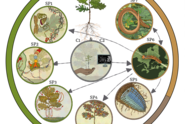Ramos, S.E., Bakhtiari, M., Castañeda-Zárate, M., Iriart, V. and Ashman, T.-L. (2022). Herbicides and Their Potential to Disrupt Plant-Insect Chemical Communication. Journal of Systematics &. Evolution. doi.org/10.1111/jse.12851
Alexander, N., Haj, D., Bakhtiari, M., Chatla, K, Aguilar, J, Arzumanova, K. Whiteman, N. A. (2021). Reference Genome Assembly of Hybrid-Derived California Wild Radish (Raphanus sativus x raphanistrum), Journal of Heredity. esab076. doi.org/10.1093/jhered/esab076.
Bakhtiari, M, Glauser, G., Defossez, E. and Rasmann, S. (2021). Ecological convergence of secondary phytochemicals along elevational gradients. New Phytologist, 229: 1755-1767. doi.org/10.1111/nph.16966.
Bakhtiari, M., Rasmann, S. (2020). Variation in Below-to Aboveground Systemic Induction of Glucosinolates Mediates Plant Fitness Consequences under Herbivore Attack. Journal of Chemical Ecology. 46, 317–329. doi.org/10.1007/s10886-020-01159-5.
Bakhtiari, M, Formenti, L, Caggìa, V, Glauser, G, Rasmann, S. (2019). Variable effects on growth and defense traits for plant ecotypic differentiation and phenotypic plasticity along elevation gradients. Ecology & Evolution. 9: 3740– 3755. doi.org/10.1002/ece3.4999.
Bakhtiari M, Glauser, G., Rasmann, S. (2018). Root JA Induction Modifies Glucosinolate Profiles and Increases Subsequent Aboveground Resistance to Herbivore Attack in Cardamine hirsuta. Frontiers in Plant Science, 9, 1230-1240. doi.org/10.3389/fpls.2018.01230.
Knauer, A.C., Bakhtiari, M. & Schiestl, F.P. (2018). Crab spiders impact floral-signal evolution indirectly through the removal of florivores. Nature Communication. 9, 1367. doi.org/10.1038/s41467-018-03792-x.
Kergunteuil A., Bakhtiari M., Rasmann, S. (2018) Eco-evolutionary Factors Driving Plant-Mediated Above–Belowground Invertebrate Interactions along Elevation Gradients. In: Ohgushi T., Wurst S., Johnson S. (eds) Aboveground–Belowground Community Ecology. Ecological Studies (Analysis and Synthesis), vol 234. Springer, Cham. doi.org/10.1007/978-3-319-91614-9_10.
Kergunteuil, A.; Bakhtiari, M.; Formenti, L.; Xiao, Z.; Defossez, E.; Rasmann, S. (2016). Biological Control beneath the Feet: A Review of Crop Protection against Insect Root Herbivores. Insects, 7(4), 70-92. doi.org/10.3390/insects7040070.



